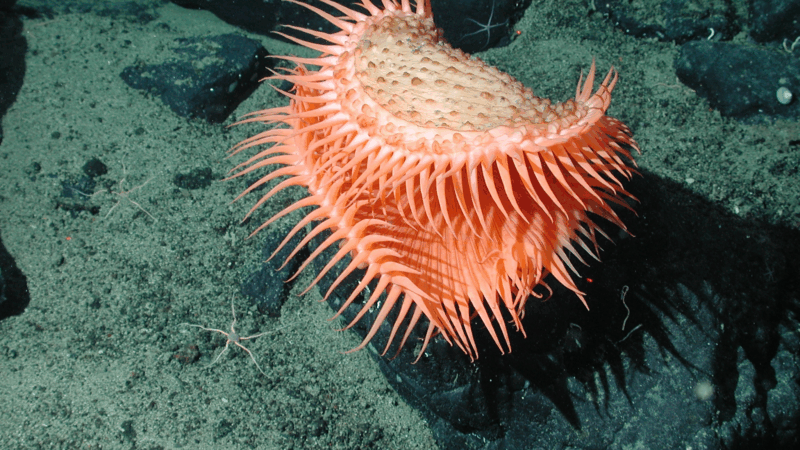Humans still haven’t seen 99.999% of the deep seafloor
Bizarre creatures like vampire squid and blobfish make their home in the dark, cold, depths of the deep sea, but most of this watery realm remains a complete mystery.
That’s because humans have seen less than 0.001% of the globe’s deep seafloor, according to a new study.
In fact, the area of the deep seafloor that’s been directly visualized is roughly equivalent to the state of Rhode Island, researchers report in the journal Science Advances.
Maps created with tools like sonar can show the shape of the seafloor, but it’s much harder to send cameras down beyond 200 meters, or more than 656 feet, where sunlight begins to fade rapidly and the waters turn cold and dark. This is the region of the ocean that’s considered “deep.”
“The fact of the matter is, when you’re down there with a remotely operated vehicle or other sort of deep-submergence vehicle, you can only see a very tiny bit of the deep sea floor at any one time,” says Katy Croff Bell of the nonprofit Ocean Discovery League, who led this new research.
She personally has been exploring the deep sea for about a quarter century. “But it wasn’t until about four or five years ago that I thought to myself, well, how much have we actually seen?” she explains. “And I started trying to find that statistic.”
She saw estimates ranging from less than one percent to as much as ten percent.
To try to get a better accounting of the total area of the deep seafloor that’s been observed so far, she and her colleagues created a database of all known efforts. They found records of more than 43,000 trips down, starting in 1958, with everything from robotic vehicles to human-driven subs to simple landers that didn’t move around.
It turns out that most of the exploratory expeditions occurred within 200 nautical miles of the United States, Japan, and New Zealand. Those three countries, along with France and Germany, led nearly all of the efforts.
As a result, scientists really haven’t seen a very representative sample of what’s going on around the globe.
“The Indian Ocean is one of the least explored areas,” she says.
Bell says we don’t know what habitats might yet be discovered — and that even though the deep ocean might be out of sight and out of mind for most people, the currents down there bring oxygen and key nutrients up towards the surface.
“All of these things are connected, and impact us in so many different ways,” she says.
What little has been explored beneath the deep ocean suggests that it can have dramatically different ecosystems that support very different kinds of living things. Already, in the ocean, explorers have seen hot hydrothermal vents, alkaline vents, and cold seeps.
“But given how little we’ve seen and how biased it is, we can’t really give you a global map of all the habitats of the deep sea, because we just haven’t been to all of them,” she says.
Past explorations to the deep have revealed completely unexpected forms of life. For example, in the 1970’s, researchers discovered microbes at hydrothermal vents that did not depend at all on the sun and photosynthesis, and instead got their energy from chemical reactions.
“That was completely revolutionary and completely rewrote all the science books,” she says.
Geologist and deep sea expert Jeffrey Karson of Syracuse University, who wasn’t part of this research team, says this is the first time he’s ever seen a well-documented number that really encapsulates what’s been seen of the deep ocean floor so far.
He would have assumed the area seen by humanity was less than 1% of the total, he says, but was still surprised the faction would be “such a tiny number.”
“We’re spending a lot of money to try to understand other planets, maybe planets outside of our solar system. And yet right here on our own planet, we know so little of what’s going on in this area that covers about two-thirds of our planet,” says Karson. “Almost every time we go there, we learn something new and exciting, and many of our discoveries on the seafloor have been serendipitous. So, you know, we’re feeling our way in the dark, literally, there.”
Changing how ocean exploration is done will require a focus on developing low-cost technologies that are available to more communities around the world, says Jon Copley, a marine biologist with the University of Southampton in the United Kingdom.
“If I were a billionaire philanthropist and I wanted to make a real dent in exploring the ocean, then rather than building a kind of superyacht research ship, I would fully back the development and growth of these kinds of low-cost platforms,” says Copley.
He says this new study shows that a lot of places on the deep seafloor that are known to be interesting have been visited repeatedly over the years, but that’s not a bad thing.
“It’s always great to go and see what’s over the next rise, what’s just out of sight of your pool of light from your deep diving vehicle,” he says. “But there is, of course, an important need to go back to the same place again and again to see how things change over time.”
Light from satellites will ruin majority of some space telescope images, study says
Astronomers have long been concerned about reflections from satellites showing up in images taken by telescopes and other scientific instruments.
Defense Department is reviewing boat strike video for possible release, Hegseth says
In a speech on Saturday, Defense Secretary Pete Hegseth defended the strikes, saying: "President Trump can and will take decisive military action as he sees fit to defend our nation's interests."
Bama, Miami in, Notre Dame out and Indiana No. 1 in College Football Playoff rankings
Nobody paying attention for the past 24 months would be surprised to see Indiana – yes, Indiana – leading the way into this year's College Football Playoff.
McLaren’s Lando Norris wins first F1 title at season-ending Abu Dhabi Grand Prix
Red Bull driver and defending champion Max Verstappen won the race with Norris placing third, which allowed Norris to finish two points ahead of Verstappen in the season-long standings.
A ban on feeding pigeons ruffles lots of feathers in Mumbai
The pigeon population has exploded — a result of people feeding the birds. For some it's a holy duty and a way to connect to nature. Critics point to health risks tied to exposure to pigeon droppings.
UN humanitarian chief: world needs to ‘wake up’ and help stop violence in Sudan
The UN's top humanitarian and emergency relief official has told NPR that the lack of attention from world leaders to the war in Sudan is the "billion dollar question".








